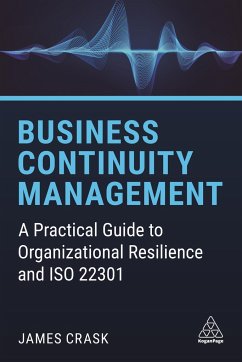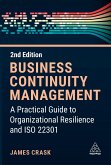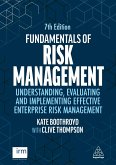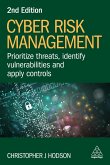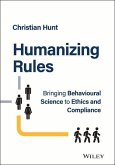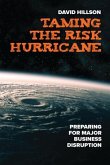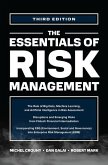James Crask
Business Continuity Management
A Practical Guide to Organizational Resilience and ISO 22301
James Crask
Business Continuity Management
A Practical Guide to Organizational Resilience and ISO 22301
- Broschiertes Buch
- Merkliste
- Auf die Merkliste
- Bewerten Bewerten
- Teilen
- Produkt teilen
- Produkterinnerung
- Produkterinnerung
Deliver a best practice business continuity and resilience framework guided by ISO 22301:2019 with case studies, templates and practical solutions for any organization.
Andere Kunden interessierten sich auch für
![Business Continuity Management Business Continuity Management]() James CraskBusiness Continuity Management39,99 €
James CraskBusiness Continuity Management39,99 €![Fundamentals of Risk Management Fundamentals of Risk Management]() Kate BoothroydFundamentals of Risk Management44,99 €
Kate BoothroydFundamentals of Risk Management44,99 €![Cyber Risk Management Cyber Risk Management]() Christopher J HodsonCyber Risk Management39,99 €
Christopher J HodsonCyber Risk Management39,99 €![Humanizing Rules Humanizing Rules]() Christian Hunt (Human Risk)Humanizing Rules26,99 €
Christian Hunt (Human Risk)Humanizing Rules26,99 €![Taming the Risk Hurricane: Preparing for Major Business Disruption Taming the Risk Hurricane: Preparing for Major Business Disruption]() David HillsonTaming the Risk Hurricane: Preparing for Major Business Disruption24,99 €
David HillsonTaming the Risk Hurricane: Preparing for Major Business Disruption24,99 €![The Essentials of Risk Management, Third Edition The Essentials of Risk Management, Third Edition]() Michel CrouhyThe Essentials of Risk Management, Third Edition42,99 €
Michel CrouhyThe Essentials of Risk Management, Third Edition42,99 €![Green and Sustainable Finance Green and Sustainable Finance]() Simon ThompsonGreen and Sustainable Finance53,99 €
Simon ThompsonGreen and Sustainable Finance53,99 €-
-
-
Deliver a best practice business continuity and resilience framework guided by ISO 22301:2019 with case studies, templates and practical solutions for any organization.
Hinweis: Dieser Artikel kann nur an eine deutsche Lieferadresse ausgeliefert werden.
Hinweis: Dieser Artikel kann nur an eine deutsche Lieferadresse ausgeliefert werden.
Produktdetails
- Produktdetails
- Verlag: Kogan Page Ltd
- Artikelnr. des Verlages: 13305
- Seitenzahl: 344
- Erscheinungstermin: 3. April 2021
- Englisch
- Abmessung: 233mm x 158mm x 22mm
- Gewicht: 546g
- ISBN-13: 9781789668131
- ISBN-10: 1789668131
- Artikelnr.: 60074626
- Herstellerkennzeichnung
- Kogan Page
- 45 Gee Street
- EC1V 3RS London, GB
- 0044 2072780433
- Verlag: Kogan Page Ltd
- Artikelnr. des Verlages: 13305
- Seitenzahl: 344
- Erscheinungstermin: 3. April 2021
- Englisch
- Abmessung: 233mm x 158mm x 22mm
- Gewicht: 546g
- ISBN-13: 9781789668131
- ISBN-10: 1789668131
- Artikelnr.: 60074626
- Herstellerkennzeichnung
- Kogan Page
- 45 Gee Street
- EC1V 3RS London, GB
- 0044 2072780433
James leads the Business Resilience advisory services at Marsh based in London, UK. He has extensive experience of delivering Business Continuity Management, Crisis Management, Supply Chain and Operational Resilience projects across a wide range of industries. He previously worked for PwC where he was responsible for building the firm's enterprise resilience advisory services. He has also held Head Risk Management roles for the Nuclear Decommissioning Authority in the UK and for the British Broadcasting Corporation (BBC). Outside of his day to day role; James chairs the International Standards Committee (ISO) responsible for the development of all global Business Continuity and Organizational Resilience Standards. Under his chairmanship the group has published a wide range of Standards including ISO 22316 (Organizational Resilience) and the 2019 revision of ISO 22301 and ISO 22313 (Business Continuity Management). Through his ISO role and broader consulting experience, James is regularly asked to speak at conferences on the subject of Business Continuity and Resilience. He is also often quoted in the media having appeared on, or been quoted by the BBC, CNN and the Times newspaper. Prior to his consulting experience, James worked for the UK Cabinet Office where he was responsible for planning for terrorism events during the London Olympic Games in 2012. This role involved working to support Government Ministers in responding to national emergencies as part of the UK's crisis response structures (otherwise known as COBR). James in an Honorary Member of the Business Continuity Institute (BCI).
Chapter
00: About the author; Chapter
01: Introduction; Section
PART ONE: Core principles; Chapter
02: The evolution of resilience; Chapter
03: What can we learn from international standards?; Chapter
04: How business continuity and resilience differs between industries; Chapter
05: Comparing incident management, crisis management and business continuity; Chapter
06: Good practice in crisis response; Chapter
07: Lessons for business continuity and resilience from COVID
19; Section
PART TWO: Guidance on delivering an effective business continuity capability; Chapter
08: Gaining and maintaining the attention of the board; Chapter
09: Developing the governance and implementing resources; Chapter
10: Delivering the BIA and determining recovery strategies; Chapter
11: Writing plans and procedures; Chapter
12: Training and exercising; Chapter
13: Supply chain resilience; Chapter
14: Reviewing, auditing and improving; Section
PART THREE: Templates and checklists; Chapter
15: Plan contents and tips for completion; Chapter
16: Response templates; Chapter
17: Assurance scorecard; Chapter
18: Index;
00: About the author; Chapter
01: Introduction; Section
PART ONE: Core principles; Chapter
02: The evolution of resilience; Chapter
03: What can we learn from international standards?; Chapter
04: How business continuity and resilience differs between industries; Chapter
05: Comparing incident management, crisis management and business continuity; Chapter
06: Good practice in crisis response; Chapter
07: Lessons for business continuity and resilience from COVID
19; Section
PART TWO: Guidance on delivering an effective business continuity capability; Chapter
08: Gaining and maintaining the attention of the board; Chapter
09: Developing the governance and implementing resources; Chapter
10: Delivering the BIA and determining recovery strategies; Chapter
11: Writing plans and procedures; Chapter
12: Training and exercising; Chapter
13: Supply chain resilience; Chapter
14: Reviewing, auditing and improving; Section
PART THREE: Templates and checklists; Chapter
15: Plan contents and tips for completion; Chapter
16: Response templates; Chapter
17: Assurance scorecard; Chapter
18: Index;
Chapter
00: About the author; Chapter
01: Introduction; Section
PART ONE: Core principles; Chapter
02: The evolution of resilience; Chapter
03: What can we learn from international standards?; Chapter
04: How business continuity and resilience differs between industries; Chapter
05: Comparing incident management, crisis management and business continuity; Chapter
06: Good practice in crisis response; Chapter
07: Lessons for business continuity and resilience from COVID
19; Section
PART TWO: Guidance on delivering an effective business continuity capability; Chapter
08: Gaining and maintaining the attention of the board; Chapter
09: Developing the governance and implementing resources; Chapter
10: Delivering the BIA and determining recovery strategies; Chapter
11: Writing plans and procedures; Chapter
12: Training and exercising; Chapter
13: Supply chain resilience; Chapter
14: Reviewing, auditing and improving; Section
PART THREE: Templates and checklists; Chapter
15: Plan contents and tips for completion; Chapter
16: Response templates; Chapter
17: Assurance scorecard; Chapter
18: Index;
00: About the author; Chapter
01: Introduction; Section
PART ONE: Core principles; Chapter
02: The evolution of resilience; Chapter
03: What can we learn from international standards?; Chapter
04: How business continuity and resilience differs between industries; Chapter
05: Comparing incident management, crisis management and business continuity; Chapter
06: Good practice in crisis response; Chapter
07: Lessons for business continuity and resilience from COVID
19; Section
PART TWO: Guidance on delivering an effective business continuity capability; Chapter
08: Gaining and maintaining the attention of the board; Chapter
09: Developing the governance and implementing resources; Chapter
10: Delivering the BIA and determining recovery strategies; Chapter
11: Writing plans and procedures; Chapter
12: Training and exercising; Chapter
13: Supply chain resilience; Chapter
14: Reviewing, auditing and improving; Section
PART THREE: Templates and checklists; Chapter
15: Plan contents and tips for completion; Chapter
16: Response templates; Chapter
17: Assurance scorecard; Chapter
18: Index;

